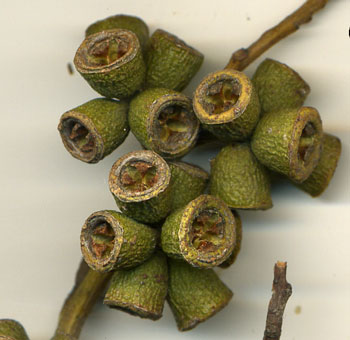Eucalyptus botryoides
 bangalay
bangalay
This sizable tree has finely rough bark on the trunk and larger branches and may be confidently identified on campus from the flower buds and fruit, which come in sevens, for the most part, and with a strap-shaped peduncle. The flower buds are about ½ inch long, consisting of a cylinder and a hemispherical lid that looks just a little oversized. The seven-seed capsules, when ripe, look very crowded, not having pedicels. (Botrys is Greek for grape and botryoides means like a bunch of grapes.) Once these distinctive features have been witnessed the tree will be recognizable from either the buds or fruit alone.
The leaf veins may be hard to see but are inclined at 60 degrees to the midvein and therefore short (not like those of the river red gum, whose veins run more nearly longitudinally). E. robusta is closely related, with similar features that are more exaggerated in a characteristic way.

There are three specimens about 20 feet south of the southeast corner of Hoover Tower on Crothers Way. One of these was sawn off at ground level when it was about 16 inches in diameter; in 2001 one sprout was 25 feet high and 6 inches in diameter, the others have been pruned off, offering a chance to compare juvenile leaves with mature leaves. There is a beautiful specimen between Durand and McCullough buildings, near three tall Corymbia citriodora (syn. E. citriodora), the fascinating lemon-scented gum.
Prof. Matt Ritter writes:
The tree on the Eucalyptus walk that was described as a E. botryoides hybrid appears to actually be one. It matches E. botryoides in all its characters except that it has wholly smooth bark. There are no close relatives of E. botryoides with wholly smooth bark so this may be a strange cultivar, individual, mutant, or hybrid. I’m not sure.
Peggy Annabel writes (January 1, 2011):
This could be a hybrid with Eucalyptus saligna (sydney blue gum) or Eucalyptus grandis both very similar with smooth barks and they do hybridize with E. botryoides in my area in Sydney Australia.
Name derivation: Eucalyptus – well covered; botryoides – bunch of grapes.
About this Entry: The main text of this entry is from the book Trees of Stanford and Environs, by Ronald Bracewell, published 2005. John Rawlings subsequently added the Durand–McCullough location & notes from Ritter & Annabel (2011 or earlier).




